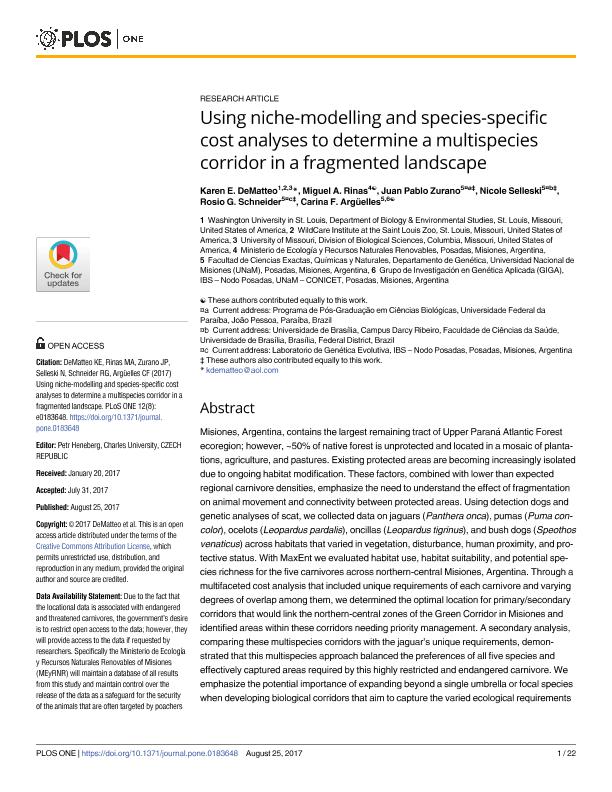Mostrar el registro sencillo del ítem
dc.contributor.author
Dematteo, Karen

dc.contributor.author
Rinas, Miguel A.
dc.contributor.author
Zurano, Juan Pablo

dc.contributor.author
Selleski, Nicole
dc.contributor.author
Schneider, Rosio Gabriela

dc.contributor.author
Argüelles, Carina Francisca

dc.date.available
2018-10-31T15:05:07Z
dc.date.issued
2017-08
dc.identifier.citation
Dematteo, Karen; Rinas, Miguel A.; Zurano, Juan Pablo; Selleski, Nicole; Schneider, Rosio Gabriela; et al.; Using niche-modelling and species-specific cost analyses to determine a multispecies corridor in a fragmented landscape; Public Library of Science; Plos One; 12; 8; 8-2017; 1-22; e0183648
dc.identifier.uri
http://hdl.handle.net/11336/63363
dc.description.abstract
Misiones, Argentina, contains the largest remaining tract of Upper Paraná Atlantic Forest ecoregion; however, ~50% of native forest is unprotected and located in a mosaic of plantations, agriculture, and pastures. Existing protected areas are becoming increasingly isolated due to ongoing habitat modification. These factors, combined with lower than expected regional carnivore densities, emphasize the need to understand the effect of fragmentation on animal movement and connectivity between protected areas. Using detection dogs and genetic analyses of scat, we collected data on jaguars (Panthera onca), pumas (Puma concolor), ocelots (Leopardus pardalis), oncillas (Leopardus tigrinus), and bush dogs (Speothos venaticus) across habitats that varied in vegetation, disturbance, human proximity, and protective status. With MaxEnt we evaluated habitat use, habitat suitability, and potential species richness for the five carnivores across northern-central Misiones, Argentina. Through a multifaceted cost analysis that included unique requirements of each carnivore and varying degrees of overlap among them, we determined the optimal location for primary/secondary corridors that would link the northern-central zones of the Green Corridor in Misiones and identified areas within these corridors needing priority management. A secondary analysis, comparing these multispecies corridors with the jaguar’s unique requirements, demonstrated that this multispecies approach balanced the preferences of all five species and effectively captured areas required by this highly restricted and endangered carnivore. We emphasize the potential importance of expanding beyond a single umbrella or focal species when developing biological corridors that aim to capture the varied ecological requirements of coexisting species and ecological processes across the landscape. Detection dogs and genetic analyses of scat allow data on multiple species to be collected efficiently across multiple habitat types independent of the degree of legal protection. These data used with multi-focal GIS analyses balance the varying degree of overlap and unique properties among them allowing for comprehensive conservation strategies to be developed relatively rapidly. Our comprehensive approach serves as a model to other regions faced with habitat loss and lack of data. The five carnivores focused on in our study have wide ranges, so the results from this study can be expanded and combined with surrounding countries, with analyses at the species or community level.
dc.format
application/pdf
dc.language.iso
eng
dc.publisher
Public Library of Science

dc.rights
info:eu-repo/semantics/openAccess
dc.rights.uri
https://creativecommons.org/licenses/by/2.5/ar/
dc.subject
Carnivores
dc.subject
Detection Dogs
dc.subject
Niche Modelling
dc.subject
Maxent
dc.subject
Multispecies Corridor
dc.subject.classification
Otras Ciencias Biológicas

dc.subject.classification
Ciencias Biológicas

dc.subject.classification
CIENCIAS NATURALES Y EXACTAS

dc.title
Using niche-modelling and species-specific cost analyses to determine a multispecies corridor in a fragmented landscape
dc.type
info:eu-repo/semantics/article
dc.type
info:ar-repo/semantics/artículo
dc.type
info:eu-repo/semantics/publishedVersion
dc.date.updated
2018-10-25T13:36:39Z
dc.identifier.eissn
1932-6203
dc.journal.volume
12
dc.journal.number
8
dc.journal.pagination
1-22; e0183648
dc.journal.pais
Estados Unidos

dc.journal.ciudad
San Francisco
dc.description.fil
Fil: Dematteo, Karen. Washington University in St. Louis; Estados Unidos. University of Missouri; Estados Unidos. Consejo Nacional de Investigaciones Científicas y Técnicas; Argentina
dc.description.fil
Fil: Rinas, Miguel A.. Provincia de Misiones. Ministerio de Ecología y Recursos Naturales Renovables; Argentina
dc.description.fil
Fil: Zurano, Juan Pablo. Universidad Nacional de Misiones. Facultad de Ciencias Exactas, Químicas y Naturales; Argentina
dc.description.fil
Fil: Selleski, Nicole. Universidad Nacional de Misiones. Facultad de Ciencias Exactas, Químicas y Naturales; Argentina
dc.description.fil
Fil: Schneider, Rosio Gabriela. Universidad Nacional de Misiones. Facultad de Ciencias Exactas, Químicas y Naturales; Argentina. Consejo Nacional de Investigaciones Científicas y Técnicas. Centro Científico Tecnológico Conicet - Nordeste; Argentina
dc.description.fil
Fil: Argüelles, Carina Francisca. Universidad Nacional de Misiones. Facultad de Ciencias Exactas, Químicas y Naturales; Argentina. Consejo Nacional de Investigaciones Científicas y Técnicas. Centro Científico Tecnológico Conicet - Nordeste. Instituto de Biología Subtropical. Instituto de Biología Subtropical - Nodo Posadas | Universidad Nacional de Misiones. Instituto de Biología Subtropical. Instituto de Biología Subtropical - Nodo Posadas; Argentina
dc.journal.title
Plos One

dc.relation.alternativeid
info:eu-repo/semantics/altIdentifier/doi/https://doi.org/10.1371/journal.pone.0183648
dc.relation.alternativeid
info:eu-repo/semantics/altIdentifier/url/https://journals.plos.org/plosone/article?id=10.1371/journal.pone.0183648
Archivos asociados
